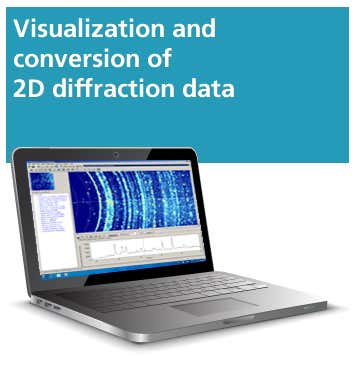Features
Analysis of 2D diffraction and scattering data
2D diffraction and scattering data contain a vast amount of information. XRD2DScan offers a comprehensive and easy-to-use toolbox to extract and analyze this information.
Apart from the detection of the crystalline (minerals) and amorphous (polymers) phases you can study their microstructure characteristics (grain size, preferential orientation, crystallinity, degree of order, etc.), you can calculate pole figures for textured samples and analyze sample inhomogeneity by mapping peak intensity, 2Theta position, and peak width using a set of 2D patterns. Mapping functionality is also a very useful tool for convenient representation and review of a well-plate data set.
2D data treatment and corrections
Apart from 2D data analysis tools, XRD2DScan offers several useful options for data treatment and correction, incl. a flat-field correction, background correction, masking of direct beam or strong reflections (e.g. from a substrate). You can also rotate and crop a 2D image, can improve the quality of a 2D image by applying data binning, smoothing, etc. You can merge multiple files to improve peak-to-noise ratio or to get a summative representation of a multiple file set. The resulting 2D image can be exported as XRDML, ASC, PSF or BMP file.
Generation of 1D scans from 2D data
XRD2DScan can visualize various 2D data types (2D XRD, pole figure, maps, incl. reciprocal space map. etc) and can read various file formats (XRDML, PSF, ASC, TIF, etc.). You can also work with 2D files measured on third party diffractometers. XRD2DScan allows you also to extract various types of 1D scans: 2theta scans (equatorial), gamma scans (axial), line scans (in any direction), Psi scan (pole figure intensity as a function of sample tilt angle at given azimuthal rotation angle), Phi scan (pole figure intensity as a function of azimuthal rotation angle at a given sample tilt angle). For a set of 2D files it is also possible to plot a Z scan (an integral sector intensity as a function of a file number).
1D scan(s) can be extracted from the entire 2D image or from a part of the image – a sector. XRD2DScan supports the definition of rectangular and angular 2D sectors. It is then possible to export 2theta scans derived from the intensities recorded in the selected sector. This is extremely useful for samples with strong texture or large grain size.
Toolbox for 1D scan treatment includes background correction, peak finding and peak fitting. For further analysis using other programs (e.g. HighScore, HighScore Plus and EasySAXS) the 1D scans can be exported as XRDML, ASC, DAT or 2Dint files.
Other useful tools
XRD2DScan also offers several handy tools like sample-detector distance calibration, multiple options to determine pattern centre, correct integration of 2D data measured using line focus of an X-ray tube, option to specify required instrument settings, option to simulate pole figure coverage to simplify texture experiment design.
Specification
XRD2DScan is compatible with Data Collector, HighScore (Plus), EasySAXS and Texture.
Input file types: .xrdml (2D type), .psf, .asc, .tif
Output file types (2D): .xrdml, .psf, .asc and .bmp
Output file types (1D):
- 2theta scan: .xrdml, .2Dint (for HighScore), .dat (for EasySAXS, converted in q-scan), and .bmp
- gamma scan: .asc, and .bmp
- line scan: .2Dint, .dat, .asc, and .bmp
- Z scan: .asc and .bmp
- Pole figure Phi/Psi scans: .asc and .bmp
Recommended system configuration
Designed for and runs on Windows 10 (64-bit) or Windows 11 (64 bit) Current Branch for Business operating systems.
For more information please refer to https://learn.microsoft.com/en-us/windows/release-health/release-information.
A PC configuration matching the (minimum) hardware requirements for the desired Windows operation system will be sufficient.
| Current version | 8.0 |
|---|

